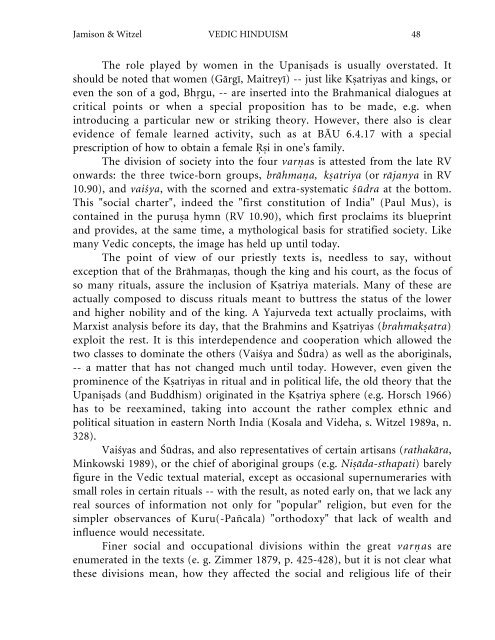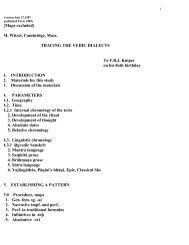VEDIC HINDUISM by S. W. Jamison and M. Witzel - people.fas ...
VEDIC HINDUISM by S. W. Jamison and M. Witzel - people.fas ...
VEDIC HINDUISM by S. W. Jamison and M. Witzel - people.fas ...
You also want an ePaper? Increase the reach of your titles
YUMPU automatically turns print PDFs into web optimized ePapers that Google loves.
<strong>Jamison</strong> & <strong>Witzel</strong> <strong>VEDIC</strong> <strong>HINDUISM</strong> 48<br />
The role played <strong>by</strong> women in the Upani�ads is usually overstated. It<br />
should be noted that women (Gårgī, Maitreyī) -- just like K�atriyas <strong>and</strong> kings, or<br />
even the son of a god, Bh�gu, -- are inserted into the Brahmanical dialogues at<br />
critical points or when a special proposition has to be made, e.g. when<br />
introducing a particular new or striking theory. However, there also is clear<br />
evidence of female learned activity, such as at BĀU 6.4.17 with a special<br />
prescription of how to obtain a female ��i in one's family.<br />
The division of society into the four var�as is attested from the late RV<br />
onwards: the three twice-born groups, bråhma�a, k�atriya (or råjanya in RV<br />
10.90), <strong>and</strong> vaiśya, with the scorned <strong>and</strong> extra-systematic śūdra at the bottom.<br />
This "social charter", indeed the "first constitution of India" (Paul Mus), is<br />
contained in the puru�a hymn (RV 10.90), which first proclaims its blueprint<br />
<strong>and</strong> provides, at the same time, a mythological basis for stratified society. Like<br />
many Vedic concepts, the image has held up until today.<br />
The point of view of our priestly texts is, needless to say, without<br />
exception that of the Bråhma�as, though the king <strong>and</strong> his court, as the focus of<br />
so many rituals, assure the inclusion of K�atriya materials. Many of these are<br />
actually composed to discuss rituals meant to buttress the status of the lower<br />
<strong>and</strong> higher nobility <strong>and</strong> of the king. A Yajurveda text actually proclaims, with<br />
Marxist analysis before its day, that the Brahmins <strong>and</strong> K�atriyas (brahmak�atra)<br />
exploit the rest. It is this interdependence <strong>and</strong> cooperation which allowed the<br />
two classes to dominate the others (Vaiśya <strong>and</strong> Śūdra) as well as the aboriginals,<br />
-- a matter that has not changed much until today. However, even given the<br />
prominence of the K�atriyas in ritual <strong>and</strong> in political life, the old theory that the<br />
Upani�ads (<strong>and</strong> Buddhism) originated in the K�atriya sphere (e.g. Horsch 1966)<br />
has to be reexamined, taking into account the rather complex ethnic <strong>and</strong><br />
political situation in eastern North India (Kosala <strong>and</strong> Videha, s. <strong>Witzel</strong> 1989a, n.<br />
328).<br />
Vaiśyas <strong>and</strong> Śūdras, <strong>and</strong> also representatives of certain artisans (rathakåra,<br />
Minkowski 1989), or the chief of aboriginal groups (e.g. Ni�åda-sthapati) barely<br />
figure in the Vedic textual material, except as occasional supernumeraries with<br />
small roles in certain rituals -- with the result, as noted early on, that we lack any<br />
real sources of information not only for "popular" religion, but even for the<br />
simpler observances of Kuru(-Pañcåla) "orthodoxy" that lack of wealth <strong>and</strong><br />
influence would necessitate.<br />
Finer social <strong>and</strong> occupational divisions within the great var�as are<br />
enumerated in the texts (e. g. Zimmer 1879, p. 425-428), but it is not clear what<br />
these divisions mean, how they affected the social <strong>and</strong> religious life of their

















